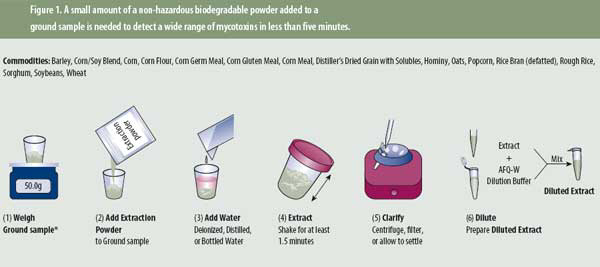Testing for Mycotoxins with a water solvent

Mycotoxins are usually extracted by using methanol and ethanol solvents which have safety and environmental burdens. A new method has been developed that permits water to be the solvent for mycotoxin detection.
By John Jabour and Dr Stanley Charm, Charm Sciences, Lawrence, MA, USA
Mycotoxins are toxic metabolites generated by moulds that affect the quality of feed and grain. These commodities are monitored and regulated for mycotoxin contamination. The detection of mycotoxins involves extraction, which is usually carried out with methanol or ethanol as solvents. However, the problem with these organic solvents is that they have burdens associated with safety for users and disposal for environment. To avoid these concerns the industry had to look for an alternative solvent.
The answer came from Chris M. Maragos of the Mycotoxin Research Unit of the USDA-ARS-NCAUR in Peoria, Illinois, USA. He wrote in his publication “Extraction of Aflatoxin B1 and G1 from Maize by Using Aqueous Sodium Dodecyl Sulfate” (Journal of AOAC International, Vol. 91, No. 4, 2008), that aflatoxin could be extracted from maize by using the in-water dispersed surfactant SDS. To quantify the contamination level the extracts were tested by HPLC. This was the first successful extraction with a water based solvent, although it is slightly toxic.
Bio-degradable powder
Based on this idea, biodegradable surfactants were dispersed in water and used with a lateral flow test to detect aflatoxin in corn. The solvent proved to be safe and could be disposed of in normal waste. Although the method (called BEST™) was approved for qualitatively detecting aflatoxin in corn by the USDA’s Grain Inspection, Packers and Stockyards Administration (GIPSA), there were still some negative aspects involved with this method. One of them was that foaming occurred and interfered with the extraction. Besides, the solvent has to be protected from microbial contamination and degradation which limits shelf life.
In addition it was difficult to use the same solvent to extract different mycotoxins.
However these negative aspects could be avoided with the help of water extraction technology (WET™). It includes the addition of a nonhazardous, biodegradable powder to a ground sample before water, for example bottled water, is used to extract mycotoxins with a Charm lateral flow test. The amount of powder used depends on sample size, for example, 1.0 g for a 10 g sample and 5.0 g for a 50 g sample. It has no foaming or storage issues and the remaining water is safe and disposable in normal waste. The WET method has been approved by GIPSA for aflatoxin in corn and other commodities as a quantitative control method. A single extraction can be used to test a wide range of mycotoxins.
[Source: Mycotoxin Special]











